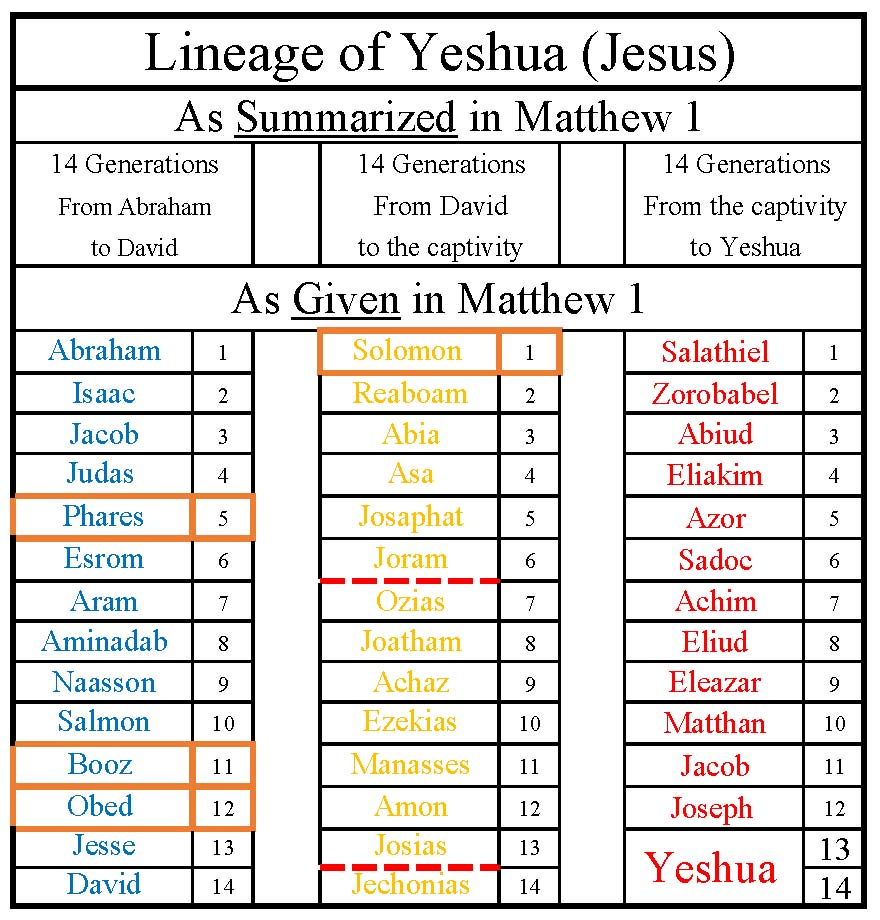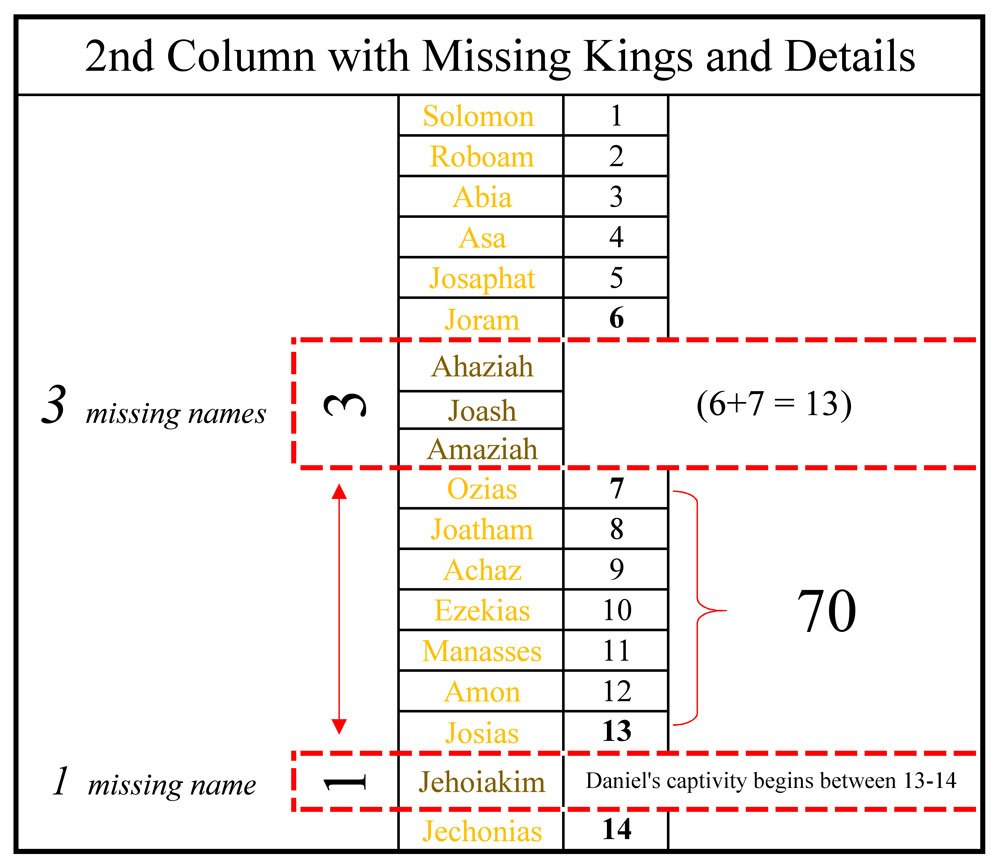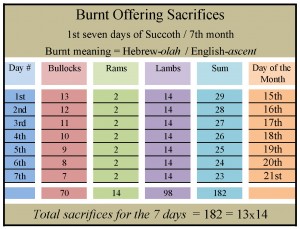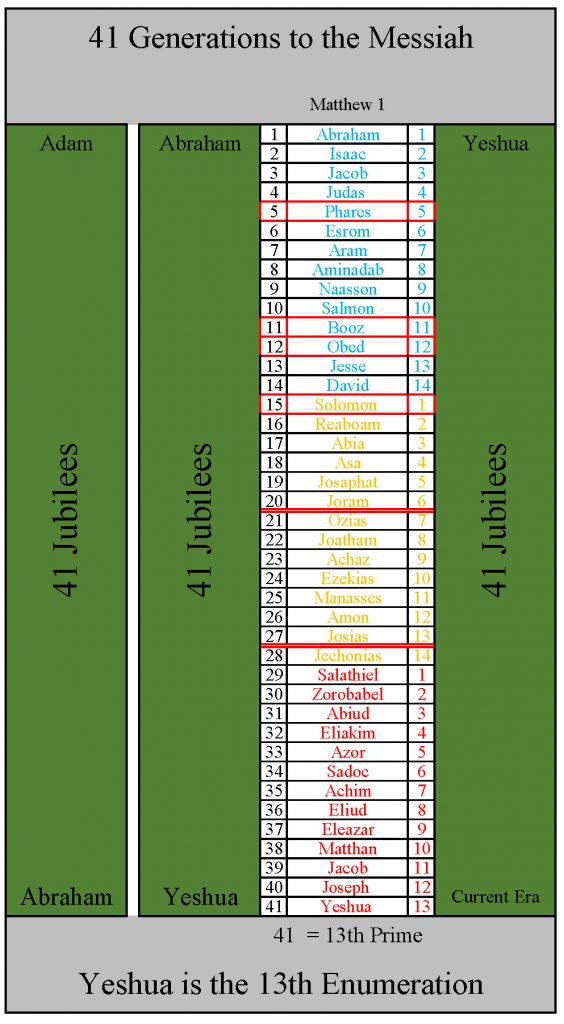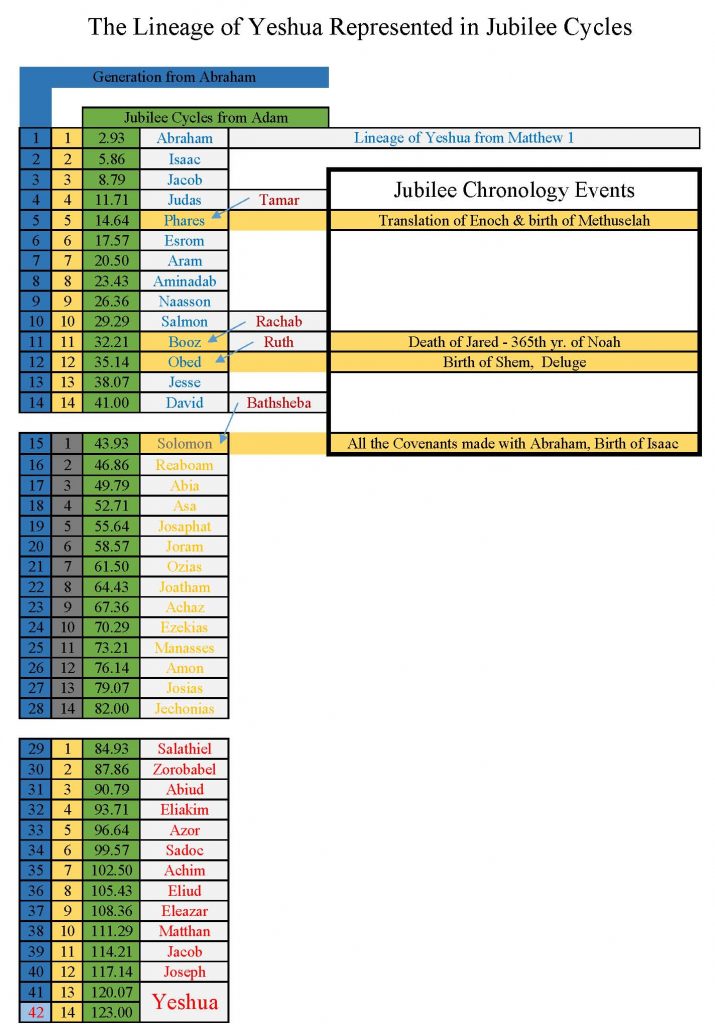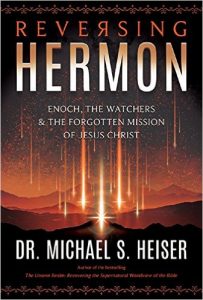 Regular readers of my blog are aware of the inspired genius Matthew concealed in the lineage of Yeshua when he wrote that intriguing list of names. As I’ve explained over the years, that list of 41 names is an important key to understanding the significance of the Bible’s messianic symbolism as it relates to the Old Testament’s sacrificial system, the Bible’s lunar/solar calendar, Daniel 9, and YHWH’s redemptive plan for mankind. As I’ve briefly discussed in several blog posts, that list also has a larger context related to Old Testament chronology, the Shemitah, and the jubilee cycles.
Regular readers of my blog are aware of the inspired genius Matthew concealed in the lineage of Yeshua when he wrote that intriguing list of names. As I’ve explained over the years, that list of 41 names is an important key to understanding the significance of the Bible’s messianic symbolism as it relates to the Old Testament’s sacrificial system, the Bible’s lunar/solar calendar, Daniel 9, and YHWH’s redemptive plan for mankind. As I’ve briefly discussed in several blog posts, that list also has a larger context related to Old Testament chronology, the Shemitah, and the jubilee cycles.
This past week I was thrilled to learn that Dr. Michael Heiser’s new book Reversing Hermon: Enoch, the Watchers & the Forgotten Mission of Jesus Christ also showcases the messianic significance of Matthew 1 in a thrilling new way. I’ll get to Dr. Heiser’s information in a moment, but let me say right up front I was skeptical when I started reading his book.
I know Enoch, fallen angels, and their gigantic offspring are popular topics in some prophecy circles right now, but I’ve been hesitant to write about the subject because the sensationalism often takes away from the true spirit of prophecy, that is YHWH’s redemptive plan through Yeshua. What I found different and encouraging about Dr. Heiser’s book is that he kept the focus of the Genesis 6 events within the context of YHWH’s redemptive plan for mankind, or as he calls it “The forgotten Mission of Jesus Christ”. I don’t agree with all of Dr. Heiser’s conclusions or theories, but his information about the lineage of Yeshua and the story of the fallen angels brings a fascinating new angle of exploration to Matthew’s important lineage of Yeshua.
In today’s blog post we’re only going to look at some of the information found in Chapter 5 of Dr. Heiser’s book as it relates to Matthew’s lineage of Yeshua. If you’d like to know more about Dr. Heiser’s book; I’ve written a review of his book and posted it to Amazon. You’ll find this review on his Amazon book page under the title Reversing Hermon in Matthew 1.
Let’s start our exploration of the subject by reading Dr. Heiser’s opening comments in Chapter 5 of his book Reversing Hermon. The title of the chapter is The Sin of the Watchers and The Genealogy of Jesus. Readers of this blog will really appreciate his words:
“Admit it. You think genealogies are boring. While I wouldn’t claim that all biblical genealogies are filled with theological insights, I can promise you that the genealogy of Jesus is different. As we’ll see, it has some amazing features that link it with the expectation of a messianic reversal of the sin of the Watchers. But you have to know what you’re looking at. By the time you’re finished with this chapter you will.
The Scholarship on the sin of the Watchers and the genealogy of Jesus is recent. 131 The connection between these two seemingly disparate topics is related to a question that has confounded interpreters ever since the Gospel of Matthew was written: Why are there four women, possible all Gentiles, in the bloodline of Jesus?
While inclusion of women in biblical genealogies isn’t unusual in itself (there are fourteen such women listed in 1 Chronicles 2, for example), the incusion of these four women is all the more odd when one realizes that “the great Jewish female figures are missing: Sarah, Rebekah, Rachel.” One would think that if Matthew thought it important to include women, these women would be more logical candidates. But they aren’t – because of what Matthew wants to telegraph about the Person whose genealogy he is presenting.”
Building on the work of New Testament scholar Amy Richter in her book Enoch and the Gospel of Matthew, Dr. Heiser explores the idea that Matthew included these women so that his 2nd temple era Jewish readers would make a connection between the “illicit arts” with which the fallen angels corrupted mankind and the promised Messiah Yeshua who would rectify or reverse the damaged caused by those events. Dr. Heiser summarizes his thesis this way:
“We began this chapter with the thesis, drawn largely from the work of Richter, that Matthew was familiar with the sin of the Watchers (the “Enochic templage”). The Watchers were blamed for sexual transgression and corrupting humanity with forbidden knowledge. All four women in the genealogy of Jesus are connected in some way with sexual transgression, seduction, and warfare. The connections are both thematic and textual. This can hardly be a coincidence. The effect of their inclusion in the genealogy is to direct readers’ attention to the One to whom the genealogy belongs: the son of Abraham, son of David, from the the tribe of Judah, born as the result of a divine-human interaction approved by God for the purpose of repairing the consequences of the proliferation of sin among humankind, a proliferation laid at the feet of the Watchers.”
To be honest, at first, Dr. Heiser’s theory seemed a little far fetched to me. But the more I thought about it, the more intrigued I became. As we explored in Book I in my Prophecy & Pattern series – The 13th Enumeration: Key to the Bible’s Messianic Symbolism, Matthew left out four Old Testament kings in Yeshua’s lineage in order to draw his readers attention to the Messianic redemptive symbolism of the Old Testament scriptures.
Remember this omission by Matthew had the effect of making Yeshua both the 13th and 14th generation in the 3rd generational grouping. That this was intentional is illustrated by the location where Matthew left out those four Old Testament kings. Matthew left out three kings between the 6th & 7th generation and one king between the 13th and 14th generation. The Jewish reader would have likely realized that his omission was intended to draw their intention to the Bible’s religious calendar because 6 & 7 is the dominate internal cycle of the solar side of calendar and 13 & 14 the dominate internal cycle of lunar side of the calendar. (The visible light of the moon waxes for 13 or 14 days each month and then wanes for the same.)
This sacrificial redemptive theme is further strengthen by the fact that each of the 7 annual Biblical holy days have 13 or 14 sacrifices associated with them in some way. The Feast of Tabernacles being especially illustrative of this fact.
This brings us back to Dr. Heiser’s thesis. I realized that if the four men left out of the list had significance to the redemptive message Matthew was trying to communicate to his Jewish readers, then it could be possible, frankly likely, that the four women added to the list had a similar significance.
Here is where it gets really fascinating. As I’ve demonstrated in a recent blog post: 41 Generations to the Messiah, a reasonable chronological case can be made that Yeshua was born in the 41st jubilee cycle from Abraham. Thus Matthew’s list of 41 generations has a larger chronological context which associates those 41 generations with 41 jubilee cycles in actual chronology. Further, the Old Testament chronology based upon the MT text of the Scripture shows us that Abraham was born in the 2008th year from Adam, thus placing Abraham’s birth in the 41st jubilee cycle from Adam. It is also worth noting that today you and I are living in the 41st jubilee cycle from Yeshua’s birth. The following chart gives an overview of this jubilee chronology:
So theoretically at least, we might venture the possibility that those three 14 generational groupings might also have a larger application and be representative of three 41 jubilee cycle epics of actual recorded Biblical history. With this theory in mind I decided to test Dr. Heiser’s thesis that the women added to the lineage of Yeshua might have additional significance.
Please note that the kings Matthew left out of Yeshua’s lineage were all in the 2nd generational grouping of 14. All the women added to the list are found in the first generational grouping of 14. This placement of the women then associates them with the 41 jubilee cycles between Adam and Abraham, the very period of Biblical history when the events of Enoch, the fallen angels and the flood took place. A good start but there is more.
If each of the 14 generations in the first generational grouping are divided into 41 jubilee cycles then each of those generations listed would be equal to 2.92857 jubilee cycles. Now since the women do not actually have a place in the lineage of Yeshua their influence on the lineage would have been felt through their descendants.
- Tamar was the mother of Phares
- Rachab was the mother of Boaz
- Ruth the mother of Obed
- Bathsheba the mother of Solomon
In the following charts you’ll find Phares, Boaz, Obed, and Solomon listed relative to the corresponding jubilee cycles which they represent in Old Testament chronology. As you can see Phares, as the 5th generation from Abraham, corresponds to the period of time when Enoch was taken to heaven. Boaz corresponds to the time of Jared during whose life the book of Enoch claims the fallen angels make their diabolical agreement on mount Hermon to defile the women of earth. Obed corresponds to the birth of Shem and the judgement of the Flood which was meant to cleans the earth of its angelic blight. Finally, Solomon corresponds to the time of Abraham, the birth of Isaac, and the covenants YHWH made with him concerning the promised “seed” who would reconcile mankind to YHWH.
Remember we learned in Book II – Daniel’s 70 Weeks: The Keystone of Bible Prophecy that this was the period of time when YHWH swore (Shaba) with Abraham, the first covenant made with any man in the Bible. That Shaba, or oath of sevens, if you will was a promise of the coming Messiah which Moses mentions in Deutoronomy 7:9, Daniel mentions in Daniel 9:4, Zacharias the father of John mentions in Luke 1, and Paul explains in several places in the New Testament.
In the following two charts I’ve tried to visually represent the lineage of Yeshua and its proposed relationship to the jubilee cycles from Adam. As you can see there is indeed compelling evidence to support Amy Richter’s and Dr. Heiser’s thesis that Matthew added the women to Yeshua’s genealogy in order to draw our attention to the events surrounding the translation of Enoch, the sin of the angelic host, the flood of Noah, and the promised Messiah whose mission included “Reversing Hermon”.
(You’ll have to enlarge the first chart. The second chart looks at the information in slightly different way with the precise dates of the jubilee cycles relative to the generations of Matthew 1.)

Fascinating, isn’t it? By adding those four women to Yeshua’s lineage, Matthew was clearly pointing his reader to the events of Genesis 6 and Satan’s plan to corrupt the “seed” or lineage of the Messiah. By juxtaposing Solomon (the illicit son of the last women included in Matthew 1) with Abraham, Isaac, and the covenants of the promised “seed”. It appears to me that the inclusion of these women was less about their sexual sins (as a reminder of the sexual transgressions of the angels as proposed by Heiser and Richter) and more about the continuity of YHWH’s redemptive plan through the messianic “seed” who was sent to restore mankind to their intended state.
I believe a comparison of the Yeshua’s lineage as found in the gospel of Matthew and Luke adds another line of exploration related to this subject.
Notice in the chart on the right that if you take the lineage of Yeshua as given in Matthew 1 and you add back the four missing kings, and then add all the Old Testament generations from Abraham to YHWH you end up with 66 names. This was the lineage of the Messiah in which the sordid nature of Yeshua’s lineage is emphasized. This is the lineage of Joseph the legal father of Yeshua and it is marked by sin.
On the other hand, the lineage of Yeshua based in Luke 1 is composed of 77 names and does not emphasize the lacking nature of the Messiah’s lineage as found in Matthew 1. This lineage is through Nathan the legitimate son of David and it details the lineage of the Messiah through Mary the daughter of Heli.
For more in this subject you might appreciate my articles: The Daughter of Heli & Zerubbabel and the Promise
In closing no matter what you believe about Genesis 6, Enoch, and the fallen angels, it is apparent that YHWH has a redemptive plan for mankind through the promised “seed” of Yeshua. It is a plan that He has nurtured and directed despite the failings of mankind and the evil machinations of the fallen angelic host.
It is equally apparent that no place in the Biblical record is that redemptive plan more masterfully displayed than in Matthew’s elegantly arranged list of 41 names whose composition and symbolism transcends the ingenuity of mankind.
* * *

